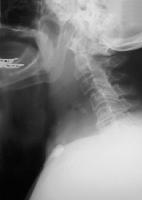-
1Antihistamines:
-
Overview:
-
Specific applications:
-
Purpose of premedication -- prevention of
intraoperative allergic reactions for those patients who
have a history of chronic atopy (predisposition towards
hypersensitivity reactions) or who will be undergoing a
procedure associated with allergic reaction such as a
radiographic studies requiring the use of a dye.
-
For these applications diphenhydramine
(Benadryl) [0.5-1 mg/kg orally) may be combined with H2
receptor antagonist (blocker). An example of an H2
receptor antagonist would be cimetidine (Tagamet) [4-6
mg/kg].
-
The combination of an H1
blocker (diphenhydramine (Benadryl)) and the H2
antagonist (cimetidine (Tagamet)) reduces the likelihood of
physiological responses to endogenous histamine release.
-
An additional agent, a steroid such as
prednisone (Deltasone) {50 mg orally every six hours for the
24-hour period preceding the surgical procedure} may be
helpful in combination with the above antihistamines.
-
Despite the use of these agents
preoperatively, allergic reactions may still occur and may
have to be managed intraoperatively
-
Other applications for histamine receptor
blockers: reduction
of gastric acid secretion
-
Mechanism: blockade of
histamine-receptor mediated gastric acid secretion by
selective, competitive inhibition; as a consequence
gastric pH increases
-
No reliable effect on gastric
fluid volume or emptying time
-
Probably appropriate as premedication
for patients with aspiration pneumonia risk.
Routine use is probably not appropriate.
-
For patients undergoing elective
surgery, costs associated with preventing a single
serious pulmonary aspiration complication may preclude
routine use of H2 blockers {this
conclusion follows from the very low likelihood of
pulmonary aspiration and & serious morbidity in this
patient group}-- also note that these drugs would not be
expected to be 100% effective anyway.
-
Several doses are likely more effective
for increasing gastric pH compared to single
preoperative dose
-
Important reminder: Use of medications,
such as H2 receptor antagonists, to
reduce aspiration risk is much less important than
proper anesthetic technique which ensures for the
correct placement of cuffed tracheal tubes
-
Specific medications:
-
Cimetidine (Tagamet), reduces acid secretion
responses to histamine,
caffeine, hypoglycemia,
gastrin
-
Route of Administration: oral or
parenteral
-
Dosage: 150-300 mg (obese patients
may require larger doses)
-
Such administration (oral) 60-90
min
preceding surgery increases gastric acid pH to >
2.5 in most patients; however gastric fluid volume
is not significantly altered.
-
Concerning neonatal effects:
-
Probably limited since,
although cimetidine (Tagamet) crosses placental
barrier, studies resolved no difference between
use of 30 ml of antacid 1-3 hours prior to the
surgery and cimetidine (Tagamet) (300 mg) 1-3
hours before the procedure, with respect to
neonatal neurobehavorial scores
-
Duration of action: 3-4 hours
-
Prominent side effect: inhibition
of hepatic mixed-function oxidase enzyme system (cytochrome
P450 system): consequence-
-
Half-life prolongation for
drugs including diazepam (Valium), theophylline,
propranolol (Inderal), lidocaine (Xylocaine)
-
Serious cardiovascular side
effects may occur following rapid IV
administration particularly in critically
ill patients {these effects include arrhythmias,
hypotension, & cardiac arrests}
-
Ranitidine (Zantac), six times as potent as
cimetadine in inhibiting
gastric acid secretion
-
Ranitidine (Zantac) compared to
cimetidine (Tagamet):
-
Dosage:
-
Oral -- 50-200 mg
-
Parenteral: 50-100 mg {gastric
fluid pH will increase within about our}
-
Duration of action: may last as
long as 9 hr, suggesting that for very long
cases premedication with ranitidine (Zantac) may
reduce aspiration pneumonia is risk during
emergence/tracheal tube extubation
-
Side effects: probably fewer CNS or
cardiovascular side effects compared to cimetidine (Tagamet);smaller
inhibitory effect on
cytochrome P450 system than observed
with cimetidine (Tagamet)
-
Famotidine (Pepcid)
-
Generally similar to cimetidine (Tagamet)
and ranitidine (Zantac)however with a longer
elimination half-life
-
Dosage: (oral) 40 mg administered
1.5-3 hours preoperatively is likely effective in
increasing gastric pH
-
Nizatidine (Axid): similar
to the above agents in that 150-300 mg (oral) given
about two hours before the procedure will increase preoperative gastric pH
-
4Antacids:
-
Overview: Antacids are exceedingly effective in
increasing gastric fluid pH to > 2.5 when administered 15-30
minutes prior to anesthesia induction
-
Concerns associated with inhalation of gastric
fluid containing antacids:
-
Special advantages of antacids compared to H2
receptor blockers:
-
Administration of an antacid immediately
increases gastric pH, without the lag time associated with
histamine receptor blockers.
-
The antacids, however, may
increase gastric fluid volume, although this effect should not
be interpreted as to discourage antacid use and is more likely
to occur after repeated doses (such as during labor) and
especially if opioids have been given which themselves delay the
gastric emptying
-
As noted earlier for the receptor blockers,
antacids need not be routinely used, but rather used for those
selected patients who appear to have a higher risk for pulmonary
aspiration.
-
Proton pump
inhibitors:
-
Overview:
-
Specific drugs:
-
Omeprazole (Prilosec)
-
Dosage (adult):
-
Mechanism of action:
Omeprazole (Prilosec) and lansoprazole (Prevacid) bind
"irreversibly" to the proton pump. This
action result in an extended duration of action, since
new protein must be synthesized to reestablish proton
secretion function.
-
Duration of action: The
effect on gastric pH may be as long as 24 hours with
variable effects on gastric volume (omeprazole (Prilosec))
-
1Antiemetic
drugs:
-
Overview and rationale--
Antiemetic agents are included in anesthetic premedication with
the objective decreasing postoperative nausea and vomiting
incidence.
-
Factors that tend to increase
patients risk for developing postoperative nausea and vomiting:
-
Females
-
Previous history of
postoperative nausea
-
History motion sickness
-
Use of general rather than
regional anesthesia
-
Opioid (e.g. morphine,
meperidine (Demerol)) administration
-
Opthalmological or
gynecologic surgeries
-
Orthopedic shoulder surgery
-
Prophylactic use of
antiemetic agents decrease the likelihood of postoperative
nausea vomiting; however, little outcome difference has been
documented based on whether the patient receives prophylactic
medication or medication only if nausea and vomiting symptoms
occur.
-
Drugs used for prophylaxis
against postoperative nausea and vomiting:
-
Serotonin antagonists such
as: ondansetron (Zofran), tropisetron, granisetron (Kytril),dolasetron
(Anzemet)
-
Butyrophenones class
antipsychotic drugs: droperidol (Inapsine)
-
Gastrointestinal prokinetic
agents: metoclopramide (Reglan)
-
Phenothiazine class
antipsychotic drugs: perphenazine (Trilafon)
-
Administration protocols: often
given near the end of the surgical procedure by IV Route of
Administration
-
Arguments against prophylactic antiemetic use:
-
Increased cost -- at the
present particularly for the serotonin antagonist drug class
-
Possibility of dysphoria/sedation
should butyrophenones be used
-
Orthostatic hypotension (a
side effect of phenothiazine-type agents because of their
alpha-1 adrenergic receptor blocking properties)
-
A percentage of patients will
vomit independent of whether antiemetic drug prophylaxis is
used
Opisthotonus

Opisthotonus: image from Mount Allison University.,
used with permission

Torticollis

"Picture 1. 69-year-old woman presenting with torticollis and fever"

"Picture 2. Soft-tissue neck radiograph demonstrates retropharyngeal abscess
appearing as torticollis."
5From: " Torticollis"
Authored by Michael Ross, MD, Staff Physician and Associate Director of EMS, Department of Emergency Medicine, Metrowest Medical Center
Coauthored by Susan Dufel, MD, FACEP, Program Director, Associate Professor, Department of Traumatology and Emergency
Medicine, Division of Emergency Medicine, University of Connecticut School of Medicine,
emedicine site: http://www.emedicine.com/emerg/topic597.htm
References:
-
1Preoperative Medication in
Basis of Anesthesia, 4th Edition, Stoelting, R.K. and Miller, R.,
p 119- 130, 2000)
-
Hobbs, W.R, Rall, T.W., and Verdoorn, T.A., Hypnotics and Sedatives;
Ethanol In, Goodman and Gillman's The Pharmacologial
Basis of Therapeutics,(Hardman, J.G, Limbird, L.E, Molinoff, P.B.,
Ruddon, R.W, and Gilman, A.G.,eds) TheMcGraw-Hill Companies, Inc.,
1996, pp. 364-367.
-
3Sno E. White The Preoperative
Visit and Premedication in Clinical Anesthesia Practice pp.
576-583 (Robert Kirby & Nikolaus Gravenstein, eds) W.B.
Saunders Co., Philadelphia, 1994
-
4John R. Moyers
and Carla M. Vincent Preoperative Medication in Clinical Anethesia,
4th edition (Paul G. Barash, Bruce. F. Cullen, Robert K. Stoelting,
eds) Lippincott Williams & Wilkins, Philadelphia, PA, pp
551-565, 2001
-
5Michael Ross and Susan
Dufel "Torticollis" emedicine, http://www.emedicine.com/emerg/topic597.htm
|